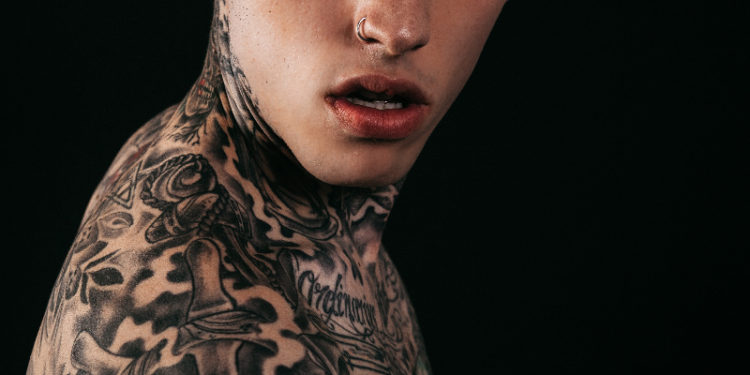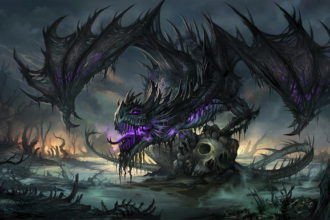Using Tattoos in your Game, P5

In part 1 we gave a definition of a tattoo,. We also examined how different classes might use tattoos,. Finally, we looked at monster markings and tattoos, as well as tattoo power levels. In part 2, we talked about how magic tattoos and other items might interact. We also discussed magic tattoo removal, how religion and different sects of society might react to the tattoos. Then we discussed activating & advancing magic tattoos. Finally we discussed creating new tattoos, and cursed tattoos. In part 3, we looked at tattoo rarity, spell Level, & Character Levels. We also discussed tattoo suggestions, and began discussing tattoos PC races might take. In the last section, we continued examining PC races and tattoos. In this article, we will cover Dwarves & Elves.
As with the previous articles, tattoo rarities are listed from [Common] to [Legendary]. Spell levels will be numbered 1 – 9.
Dwarf
“Standard Dwarves” are ever-the-practical craftsmen and warriors will typically choose tattoos that will aid them in these ventures. Such spells & abilities include:
- Enchant item [Very rare to Legendary]
- Locate Object (ground penetrating) [very rare to Legendary]. Rarity will increase the deeper it can penetrate and if certain materials block it or not.
- Forge Item: allows user to forge items 25% faster [rare] or 35% faster [very rare]
- Purify Metal: allows user to purify impure metals
- Heat metal (2nd level)
- Sharpen: gives a sharp edge to a piercing or slashing weapon, a nonmagical bonus of +1 to damage [uncommon]
Hill Dwarves
Hill dwarves, also known as Gold Dwarves would have the same tattoos as standard dwarves, but might also have the following:
- Cleric spells, particularly those that have to do with powers relating to earth, metal, and fire
- Sorcery spells, particularly ones that match the affinity for their distant dragon or elemental ancestry
- Maybe they might even tattoo themselves with the ability to summon tools for mining or gem cutting, so they’re never without them.
Mountain Dwarves
Mountain Dwarves, also known as Shield Dwarves, are mainly isolationists or wanderers. Isolationists are dwarves who wish to protect their strongholds. Wanderers, on the other hand, are those who seek out adventure or to reclaim old, forgotten strongholds. Both would tattoo themselves with protections against their hated foes:
- orcs
- goblins
- trolls, and
- giants that threaten the dwaves
The protection may come in a variety of ways:
- Temporary hit points while battling them. [Rare]
- An increase in AC, something akin to mage armor or a deflection bonus while fighting them. [Common]
- Glowing runes that lash out in retribution. Conversely, the tattooed runes may change the damage type. Magic of this nature can be particularly useful against regenerating monsters. [Rare]
Duegar
The Duegar are also known as Gray Dwarves.
- According to the Forgotten Realms Fandom surface dwellers who encounter gray dwarves notice facial and arm tattoos that marked the Duergar as a traitor to his or her people. These tattoos are nonmagical.
- Duegars who know they would be on the surface get tattoos that would help them with their sunlight sensitivity. Such tattoos that would help cover their eyes or, when activated, spread it to their enemies. [Rare] to [Very Rare]
- Anti-Psionic: because of their past relations with Mindflayers, Duegar would want to protect themselves against their powers. The tattoos might make them more resilient to their mind-blast or immune to it altogether. [Rare] to [Very Rare]
- Shadow magic: because shadow magic is partially real, perhaps a Duegar would supplement the racial spells they receive with it. [Rare]
- Maybe they would get tattoos that would let them use their innate magics of reducing/enlarging and invisibility at will. [Very Rare] to [Legendary]
Elves & Half-Elves
Elven subraces are Moon Elves, Drow, Eladrin, High Elves, and Wood Elves.
Moon Elves
Moon elves, are the “standard” elves of most fantasy settings. Also known as silver elves, they are the most common and accepting of all the elven subraces. They are a nomadic people driven by wanderlust. Because they don’t have “roots,” they’ll often be found living among other elves, gnomes, humans, and halflings. Because of this, most half elves you meet will be of moon elf origin.
Their wanderlust encourages them to take up the adventuring lifestyle. Typically, moon elves don’t take things too seriously. Instead, they prefer to enjoy life’s simple pleasures. They love exploring the untamed wilderness. When not traveling, moon elves enjoy drinking, gambling, and reveling.
Due to their varied experiences living among different peoples, they tend to pick up a variety of skills. Thus, they often could be found in the varied roles of arcane archers, artists, bards, bladesingers, fighters, rangers, rogues, and wizards.
They are fond of pets, such as cats, dogs, falcons, or other hunting partners. Many also formed close bonds with self-aware creatures. However, most moon elves do not keep mounts, preferring to walk.
Because of the varied nature of moon elves, their tattoos would be as varied as they are, but would focus on those areas that would help them the most. See part 1 for how different classes might use tattoos. Clerics who are on the road all the time may decide to take the travel domain, The DM’s Guild also has a version here.
Drow
Also known as dark elves, among other names, the Drow are a dark-skinned sub-race of elves that predominantly lived in the Underdark.
- Drow, like Duegar, would get tattoos to deal with their sunlight sensitivity. [Rare]
- In the Forgotten Realms, due to their association with Lloth and might tattoo themselves with spiderlike abilities such as resistance or immunity to spider venom (or in the case of Eberron, scorpion venom), spider climb and web. [Common] to [Rare]
- The Sulatar Drow in Eberron would tattoo themselves with fire-based spells [Common] to [Very Rare]
- Looking at the Drow’s personality traits, they might tattoo themselves with the following
- Cruelty: symbol of pain or hopelessness
- Fear: with the emotion spell
- Hedonism: tattoos that would heighten their own pleasure
- Distrust: Zone of Truth
- Vengefulness: an eye for an eye. A [legendary] tattoo that rebounds damage dealt to the one dealing it.
Eladrin
The Eladrin are fey-touched elves. They are associated with the seasons. Mechanically, they can change their season during a long rest. Instead of static tattoos, they might choose tattoos that change. Conversely, they may have tattoos that are active only during certain seasons. Look at the Druidic Circle of the Season class for inspiration. Or this one from DM’s Guild. In looking at the spell list, the character’s level would determine the spells available, as well as how often they could be cast.
High Elves
High Elves are also called Sun Elves in Forgotten Realms. Among their ranks, they have highly skilled craftsmen to whom few can compare. Like their dwarven craftsmen counterparts, city-dwelling high elves might have tattoos that summon beautifully crafted, expertly made tools. These isolated elves are less motivated to become adventurers. The few who do are often spies, scouts, and explorers gathering lost secrets to bring back with them. Because many of them end up with levels of bard, bladesinger, or arcane archers, tattoos that enhance bardic or archery related abilities that would be [Rare] or [Very Rare] for other races are [Common] for high elves.
Wood Elves
Wood elves are often stronger, but frequently less cerebral other elves. Disdaining metalwork, wood elves are among the world’s best carpenters and stoneworkers, masters in the crafting of bows and arrows as well as in leather tanning. They even have elegant-looking specialized arrows. Some arrows fly further than usual—others, as signaling devices. Wood elven leather armor also doubled as camouflage.
They are also the most isolationist of all the elves. Some might even call them almost xenophobic in their desire to avoid contact with the outside world, if possible. Wood Elves desire to live in harmony with nature. They wish to have as minimal of an impact on their natural surroundings as possible. This fact is reflected in their architecture. Frequently, their homes are fieldstone or carefully furnished wood. Sometimes they live in trees or caves, rejecting anything they couldn’t carry with them. So close do wood elf villages resemble their surroundings that humans occasionally wander through one without even noticing.
Because of this, their tattoos would reflect their love of nature and isolationistic tendencies.
- Wood Elf tattoos would amplify their strength or dexterity.
- Their tattoos would also grant them camouflage abilities in the woods they so love.
- The tattoos may also duplicate the spell Endure Elements.
Conclusion
As you can see, there are many ways to use tattoos in your game. Take a few of these ideas and change them to suit your gaming world. If any of these ideas struck a chord, and you want to use them, feel free to tell me in the comments section below!



